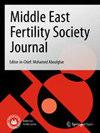Evaluating the effectiveness and adverse effects of oral versus transdermal estradiol for endometrial preparation in frozen-thawed embryo transfer: a randomized controlled trial
IF 1.3
Q4 REPRODUCTIVE BIOLOGY
引用次数: 0
Abstract
Endometrial preparation significantly influences the success of embryo transfer procedures. Although both oral and transdermal estradiol are common methods for endometrial priming, their efficacy and potential side effects remain uncertain. This randomized controlled trial aims to compare the effectiveness of oral and transdermal estradiol in endometrial preparation, while also evaluating their respective side effects in patients undergoing assisted reproduction treatments. This randomized clinical trial (ISRCTN15301227) was conducted at Hung Vuong Hospital between July 2020 and March 2022. Among 550 eligible patients undergoing frozen embryo transfer cycles, we included 380 patients for the study. The study protocol and all materials received approval from the Ethics Committee of Hung Vuong Hospital (1315/CN-HĐĐĐ). Participants were randomly assigned to one of two groups: Group A (n =190) received oral estradiol at an initial dose of 4 mg per day for 7 days, with the dose increased according to clinical response. Group B (n =190) received transdermal estradiol at an initial dose of 2 measures of 2.5 g estradiol gel per day for 7 days, with the dose similarly increased according to clinical response. Treatment in both groups began on days 2–3 of the menstrual cycle, with the maximum duration of estradiol administration being 27 days. We compared estradiol levels on the day of progesterone administration, duration of treatment, total estradiol dose, endometrial thickness, pregnancy outcomes, and any observed side effects between the two groups. Group A exhibited significantly higher estradiol levels on the day of progesterone administration compared to Group B (270.5 pg/ml versus 186.5 pg/ml, p < 0.001). However, the comparison revealed no significant difference in endometrial thickness between the two groups (10.5 mm versus 10.6 mm, p = 0.85). Furthermore, pregnancy rates including positive human chorionic gonadotropin, clinical pregnancy, ongoing pregnancy, live birth, and pregnancy failure were also found to be similar between the two groups. Notably, a greater proportion of patients in Group A experienced mild side effects compared to those in Group B (20.3% versus 10.1%, respectively; n =37 versus n =18), and this discrepancy was found to be statistically significant (p = 0.007). Transdermal estradiol offers comparable endometrial thickness and pregnancy outcomes, along with improved patient compliance and fewer side effects compared to oral estradiol.评估口服雌二醇与透皮雌二醇对冷冻解冻胚胎移植子宫内膜准备的有效性和不良影响:随机对照试验
子宫内膜准备对胚胎移植手术的成功有很大影响。虽然口服和透皮雌二醇都是子宫内膜准备的常用方法,但它们的疗效和潜在副作用仍不确定。这项随机对照试验旨在比较口服雌二醇和透皮雌二醇在子宫内膜准备中的有效性,同时评估它们对接受辅助生殖治疗的患者各自的副作用。这项随机临床试验(ISRCTN15301227)于2020年7月至2022年3月期间在洪旺医院进行。在 550 名符合条件的冷冻胚胎移植周期患者中,我们纳入了 380 名患者进行研究。研究方案和所有材料均获得了洪旺医院伦理委员会的批准(1315/CN-HĐĐ)。参与者被随机分配到两组中的一组:A组(n = 190)口服雌二醇,初始剂量为每天4毫克,持续7天,然后根据临床反应增加剂量。B组(n=190)接受透皮雌二醇治疗,初始剂量为每天2次,每次2.5克雌二醇凝胶,共7天,同样根据临床反应增加剂量。两组患者的治疗均从月经周期的第 2-3 天开始,雌二醇用药时间最长为 27 天。我们比较了两组患者在服用黄体酮当天的雌二醇水平、治疗持续时间、雌二醇总剂量、子宫内膜厚度、妊娠结果以及观察到的副作用。与 B 组相比,A 组在服用黄体酮当天的雌二醇水平明显更高(270.5 pg/ml 对 186.5 pg/ml,p < 0.001)。然而,对比结果显示,两组的子宫内膜厚度无明显差异(10.5 毫米对 10.6 毫米,p = 0.85)。此外,两组患者的妊娠率(包括人绒毛膜促性腺激素阳性、临床妊娠、持续妊娠、活产和妊娠失败)也相似。值得注意的是,与 B 组相比,A 组中出现轻微副作用的患者比例更高(分别为 20.3% 对 10.1%;n =37 对 n =18),而且这一差异具有统计学意义(p = 0.007)。与口服雌二醇相比,透皮雌二醇具有可比的子宫内膜厚度和妊娠效果,患者的依从性更好,副作用更少。
本文章由计算机程序翻译,如有差异,请以英文原文为准。
求助全文
约1分钟内获得全文
求助全文
来源期刊

Middle East Fertility Society Journal
REPRODUCTIVE BIOLOGY-
CiteScore
2.80
自引率
0.00%
发文量
32
审稿时长
45 weeks
 求助内容:
求助内容: 应助结果提醒方式:
应助结果提醒方式:


